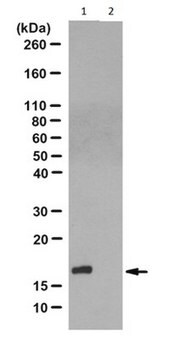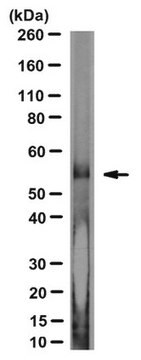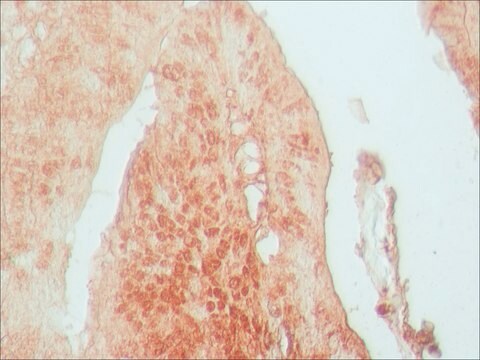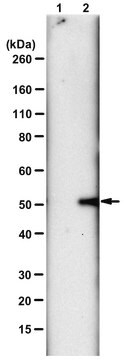ABS1670
Anti-Phosphohistidine (pHis)
from rabbit, purified by affinity chromatography
Synonym(s):
pHis, phosphohistidine
About This Item
Recommended Products
biological source
rabbit
Quality Level
antibody form
affinity isolated antibody
antibody product type
primary antibodies
clone
polyclonal
purified by
affinity chromatography
species reactivity
all, human, sheep, mouse
technique(s)
ELISA: suitable
dot blot: suitable
immunoprecipitation (IP): suitable
western blot: suitable
shipped in
ambient
target post-translational modification
phosphorylation (pHis )
Gene Information
human ... PHPT1(29085)
General description
Specificity
Immunogen
Application
Western Blotting Analysis: A 1:120 dilution from a representative lot detected proteins with histidine phosphorylation in sheep trachea cytosolic extract and human cell lysates, including 16HBE14o-, HEK293T, THP-1, and THP-1-derived macrophages (Courtesy of Bezaleel Mambwe, Richmond Muimo and RFW Jackson, Department of Infection, Immunity and Cardiovascular Disease/ Department of Chemistry, University of Sheffield, UK).
ELISA Analysis: A representative lot detected pHis- and pPza-, but not pTyr-, pSer-, pThr-, conjugated BSA or unconjugated BSA (Lilley, M., et al. (2015). Chem. Commun. (Camb). 51(34):7305-7308).
Immunoprecipitation Analysis: A representative lot immunoprecipitated proteins with histidine phosphorylation from ovine airway epithelia extract (Lilley, M., et al. (2015). Chem. Commun. (Camb). 51(34):7305-7308).
Western Blotting Analysis: A representative lot detected histidine phosphorylated proteins in 16HBE14o- human bronchial epithelial cell lysate and in ovine airway epithelia extract. Acid (0.1 M HCl or 0.4 M acetic acid/0.1 M hydroxylamine), but not alkaline (0.1 M NaOH), treatment of the lysates abolished targets bands detection (Lilley, M., et al. (2015). Chem. Commun. (Camb). 51(34):7305-7308).
Western Blotting Analysis: A representative lot detected histidine phosphorylation of immunoprecipitated NDPK-A/B from ovine airway epithelia extract, as well as G -R/M from 16HBE14o- human bronchial epithelial cell lysate (Lilley, M., et al. (2015). Chem. Commun. (Camb). 51(34):7305-7308).
Note: DO NOT HEAT SAMPLES prior to phosphohistidine detection. Histidine phosphorylation is heat and acid labile. To generate negative control for specificity test, an aliquot of sample can be heated at 95ºC for 10-15 minutes to reverse histidine phosphorylation. Alternatively, an aliquot of sample can be incubated under acidified pH at 37ºC for 15 minunites to reduce histidine phosphorylation. Acidify each 100 µL sample with 25 µL of 1 M HCl before the incubation, then neutralize with 25 µL of 1 M NaOH prior to phosphohistidine detection.
Signaling
Quality
Western Blotting Analysis: A 1:200 dilution of this antibody detected histidine-phosphorylated proteins in 10 µg of HEK293 cell lysate.
Target description
Physical form
Storage and Stability
Other Notes
Disclaimer
Not finding the right product?
Try our Product Selector Tool.
Storage Class Code
12 - Non Combustible Liquids
WGK
WGK 1
Flash Point(F)
Not applicable
Flash Point(C)
Not applicable
Regulatory Listings
Regulatory Listings are mainly provided for chemical products. Only limited information can be provided here for non-chemical products. No entry means none of the components are listed. It is the user’s obligation to ensure the safe and legal use of the product.
JAN Code
ABS1670:
Certificates of Analysis (COA)
Search for Certificates of Analysis (COA) by entering the products Lot/Batch Number. Lot and Batch Numbers can be found on a product’s label following the words ‘Lot’ or ‘Batch’.
Already Own This Product?
Find documentation for the products that you have recently purchased in the Document Library.
Our team of scientists has experience in all areas of research including Life Science, Material Science, Chemical Synthesis, Chromatography, Analytical and many others.
Contact Technical Service







